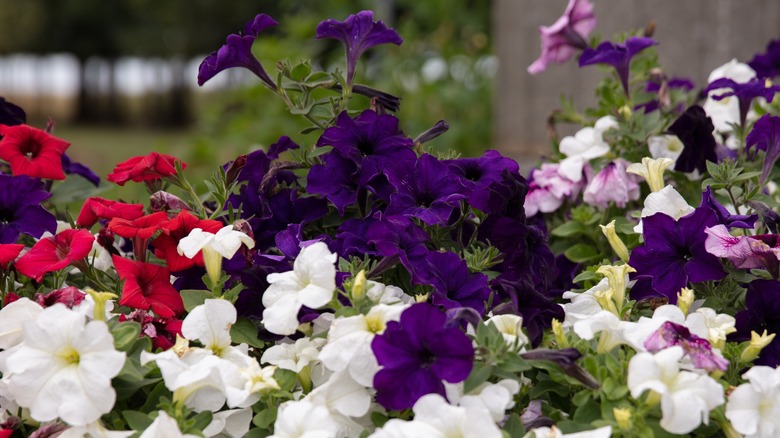Signs That Your Petunias Aren't Getting Proper Sunlight (& How To Care For Them)
Petunias are classics in the garden for good reasons: not only do they bring a riot of color and fragrance to your landscaping, but they're also a hit with pollinators. Petunias are generally considered relatively easy-to-grow flowers, but they do require full sun to perform their best. If your petunias seldom flower, are leggy or spindly, or are struggling with disease, this can indicate that they need more sunlight.
Garden petunias (Petunia x hybrida) come in a wide variety of forms, from cascading varieties, to petite milliflora cultivars, to large grandiflora varieties with flowers that are several inches across. Regardless of the specific cultivar you grow, most garden petunias have similar needs, and while they are only perennial in zones 10 and higher, they can thrive as summer annuals almost anywhere, including Alaska. While petunias have relatively flexible soil requirements, and are able to thrive in even poor soil with low fertility, they do require their soil have good drainage. Most varieties also hold up well to heat and require only occasional watering. The one area where petunias are particular is sunlight.
Signs your petunias need more light
While petunias can sometimes be grown in part shade, they require at least 5 hours of sunlight per day to grow well, and more sun is generally better. Most modern petunias cultivars are relatively disease resistant, but insufficient sunlight increases their chances of suffering from diseases and dying before the end of the growing season. Petunias that are oddly tall with spindly and weak stems are also likely suffering from insufficient light, which is causing them to stretch. Make sure you know what type of petunias you are growing though, as healthy cascading petunias could be mistaken for spindly due to their long trailing stems that are perfect for spilling out of hanging baskets. It's important to be sure you aren't overwatering your petunias either, as that too can result in leggy plants.
Another good sign your petunias aren't receiving enough sunlight is if they rarely or never bloom. Healthy garden petunias are generally prolific bloomers. While relocating your plants to a sunnier location is likely to solve most blooming issues, good blooms also require that you stay on top of deadheading your petunias and avoid making the common deadheading mistake of only removing the petals of the faded flower — be sure to remove the entire stem. Deadheading is especially important for larger flowers and doubles as they are not usually self-cleaning.
When and where to use petunias in the garden
Because petunias are such wonderful bedding annuals, it can be tempting to try to add them everywhere in your landscaping. As long as your garden has plenty of sun, petunias, like many bedding annuals, make an excellent ground cover that can also suppress weeds and attract pollinators. Petunias are also fantastic additions to container gardens and hanging baskets as long as they are either grown alone or are paired with other drought-resistant flowers and sun-loving plants like lantana and bougainvillea.
If you love the look of petunias but don't have any full sun locations where they can thrive, impatiens can make a good alternative as they have a similar flower shape and growth habit. Unlike petunias, impatiens thrive in moist soil and shade,making them ideal for those spots where petunias struggle. It's important to know before planting these petunia lookalikes that they can often suffer from downy mildew, so be sure to choose disease-resistant cultivars.


